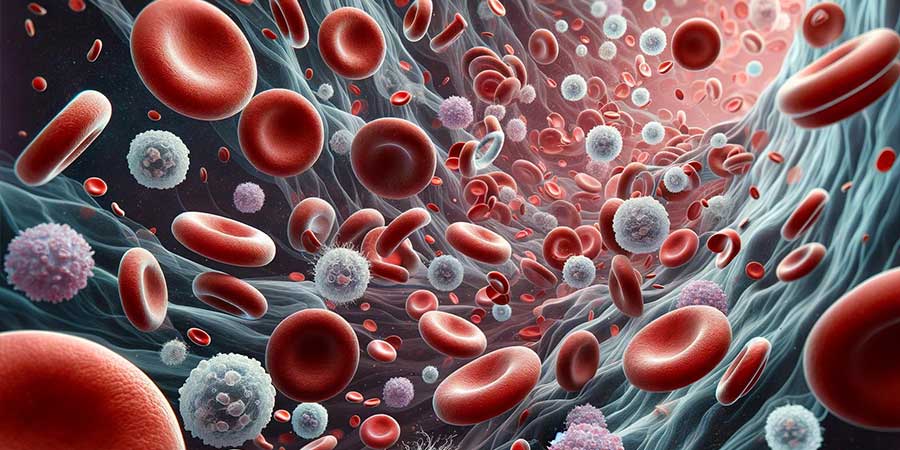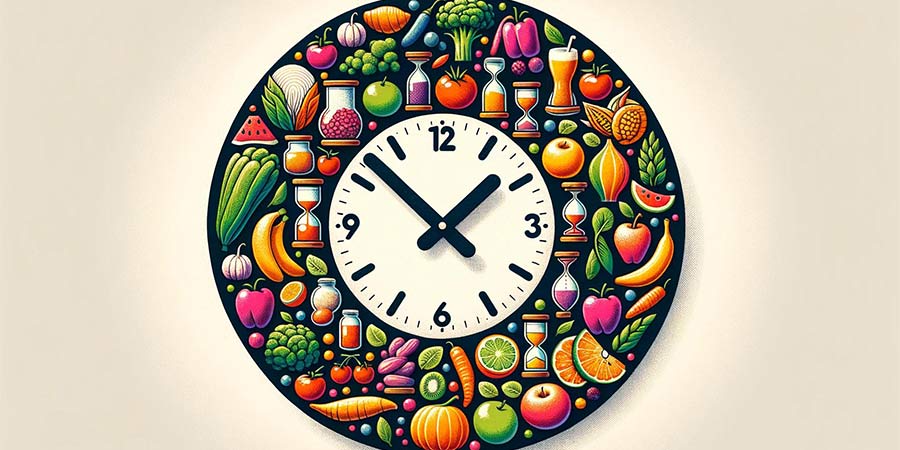Table of Contents
Intermittent fasting has roots deeply embedded in the history of human culture and traditions. This approach, characterized by intentional periods of eating followed by periods of fasting, is not merely a method for weight loss or physical cleansing. It offers significant benefits for both physical and mental well-being.
In modern stressful life, where eating habits are often irregular and unbalanced, fasting can potentially restore balance in the body and mind. It encourages a more mindful approach to eating, helping individuals develop a better understanding and respect for their needs and bodily signals.
Intermittent fasting has various benefits, such as improved metabolic health, reduced risk of chronic diseases, and even enhanced cognitive functions. It does not necessarily mean suffering or feeling hungry.
Let’s explore how fasting integrates into modern health and psychological practices, taking an interest in the scientific foundations behind its benefits and providing practical guidelines for its optimal application.
Intermittent fasting, diet, or nutritional regime – differences
We usually associate fasting with unpleasant sensations, even stomach pain, irritability, and intolerance towards everything else we have to do in daily life. The meaning is not “hunger” but “abstinence” or “interruption.” Hence the word “breakfast,” i.e., “breaking the fast.”
It doesn’t sound as lethal now. Fasting is not only associated with abstaining from food. It can be used for a water fast, alcohol fast, social fast, a fast from everything.
When we talk about “fasting,” let’s consider it as “abstaining from food.” “Diet,” “nutritional regime,” and “intermittent fasting” are often used interchangeably in the context of eating and health, but each has its specific meaning and application.

Diet
A diet is a specific set of nutritional guidelines or restrictions followed to achieve certain health or physical goals, such as weight reduction, treatment of medical conditions, or improvement of overall well-being. Diets can be temporary or long-term, often with specific directions on what foods to consume or avoid.
Nutritional Regime
The nutritional regime is used to describe an individual’s overall dietary pattern or eating style. It is shaped by various factors, including cultural habits, personal preferences, dietary restrictions due to health conditions, etc. It is a more general concept than a diet and usually refers to the long-term approach to eating.
Intermittent Fasting
Intermittent fasting is an eating method that involves eating cycles and periods of abstention. It does not focus on specific foods but rather on the timing of consumption. For example, one of the most popular forms is the 16/8 interval – 16 hours of fasting and an 8-hour window for eating, or 5/2 – five days of regular eating and two days of deficient caloric intake.
While diet and nutritional regime focus on “what” is eaten, fasting focuses on “when.”
History
Intermittent fasting is not a new concept. It has reached us through the centuries and across different cultures. Traditionally, it has been practiced for religious, spiritual, and health reasons, with many traditions, including Christianity, Islam, Judaism, and Buddhism, having their forms of fasting. These periods are spiritual exercises and times for self-reflection and renewal.
Autophagy
In the 20th century, fasting became a subject of scientific research. Scientists began to examine its potential health benefits. One of the pioneers in this field is Dr. Yoshinori Ohsumi from Japan, who, in 2016, won the Nobel Prize for his discoveries on the mechanisms of autophagy – a process where cells “self-clean”.
This is a natural and regulated process through which unnecessary or dysfunctional components are broken down. Autophagy, meaning “self-eating,” is essential for maintaining cellular health and is associated with various benefits such as improved metabolism and microbiome, increased lifespan, and reduced risk of some diseases.
After 18-20 hours without insulin spikes (i.e., without intake of carbohydrates and proteins), the body enters a state of “autophagy”. In this way, the body gets rid of harmful, old, or diseased cells and stimulates the formation of new ones.
Intermittent fasting stimulates autophagy, thereby improving overall health. Regular fasting slows aging and treats autoimmune diseases, allergies, arthritis, dementia, Parkinson’s, and many others.

How does intermittent fasting stimulate autophagy?
Intermittent fasting creates conditions of energy deficit. When food intake is limited, blood glucose levels decrease, leading to a reduction in insulin levels. This activates enzymes that signal the start of autophagy.
Fasting increases adenosine monophosphate-activated protein kinase (AMPK), an enzyme vital in managing cellular energy balance. The activation of AMPK stimulates autophagy.
Optimizing Autophagy
To enhance the benefits of autophagy through intermittent fasting, it’s essential to follow several fundamental principles:
- Choosing the Appropriate Fasting Interval: Depending on individual needs, a different time frame for eating and not eating can be selected. Fasting can be done only on full moons, every weekend, 1-2 days a week, or every day. Everyone should choose what fits their lifestyle and body best.
- Maintaining a Balanced Diet: When not fasting, focus on a nutrient-rich diet that supports overall health and well-being. Many people who practice fasting rely on a calorie deficit to maintain good shape and, during the limited time for nutrient intake, indulge in junk food. It’s normal to have a cheat day to treat yourself, but don’t punish your body with sugar and gluten when you can give it healthy leafy vegetables, quality fats, and protein.
- Moderation and Tracking Body Signals: Be moderate and attentive to the signals your body sends.
It’s a good idea, at least initially while getting used to this lifestyle, to keep a diary of the food consumed, the fasting intervals followed, and observations with sensations (both physical and mental).
Psychological and Spiritual Aspects
Intermittent fasting is not only a physical process but also a practice that can profoundly impact an individual’s mental and metaphysical state. It originates from religious traditions worldwide and is attributed to various symbolic and spiritual meanings.
Psychological Aspects
In modern society, constant access to food is readily available and used for self-soothing, dulling negative feelings, and as a source of joy.
Interrupting this cycle can encourage a more mindful attitude towards eating and the present moment. Hunger brings the wandering mind back to the body, leading to suffering that is not just physical. The realization of “now” enriches life because it stops the autopilot.
Controlling hunger, getting used to it, and overcoming the fear of not having food, in a sense, makes the psyche more resistant to the existential dread of death. The body of a hungry person automatically invokes the instinct for self-preservation and uses panic as a primary tool.
On the other hand, fasting increases self-control and provides opportunities for managing spontaneous impulses, which is especially valuable in fear, systemic overeating, and emotional eating. Once we realize we have control over the fear of hunger (death), we gain resilience to a whole cluster of life’s challenges.
The increased sense of achievement and control that comes with successfully adhering to fasting intervals improves self-esteem and self-respect. It is a source of spiritual elevation and satisfaction, as the individual personally experiences and realizes their power over elementary instincts and needs. From there, one is on the next step towards more sublime pursuits.

Spiritual and Religious Aspects
In many religious traditions, intermittent fasting is used for spiritual purification and self-improvement.
In Islam, Ramadan is a fasting period involving abstaining from food and drinks from dawn until sunset. This is considered a time for spiritual renewal and strengthening of faith. In Christianity, Lent before Easter is a period of self-restriction and reflection, often including forms of fasting. In Buddhism, monks traditionally consume food only before noon, abstaining afterward to focus on meditation and spiritual practices.
These religious aspects highlight the connection between the body, mind, and spirit and the role of self-discipline in spiritual development. In intermittent fasting, similar to religious fasting, there is an element of renunciation used as a tool to achieve a higher state of consciousness, resilience, and inner peace.
Practical Guidelines for Intermittent Fasting
Intermittent fasting should be adapted to the individual needs and lifestyle of each person. Let’s explore various fasting models and strategies for managing hunger.
Fasting Intervals
Intermittent fasting can be applied within a day, over several days, weekly, or monthly.
The 16/8 Method
This is one of the most popular intervals, where eating is limited to an 8-hour window, followed by 16 hours of fasting. For example, if you start eating at noon, you should finish by 8:00 PM and only eat the next day at noon.
In essence, this interval involves skipping breakfast. No foods or drinks that could break the fast, i.e., lead to insulin release from the pancreas, are allowed. It’s a good idea to start with this interval and gradually increase the fasting window at the expense of the eating window – for example, 20/4 – 20 hours of fasting and 4 hours for food intake.
The 5:2 Method
This method involves standard eating for five days of the week, while the other two days involve consuming a minimal amount of calories – about 500-600 for women and 600-700 for men.
24-Hour Fast
This approach involves practicing a 24-hour fast once or twice a week and for example, fasting from dinner to dinner the next day.
Alternate-Day Fasting
With alternate-day fasting, you alternate days of normal eating with minimal calorie intake (about 500 calories).
Spontaneous Meal Skipping
This approach is more flexible and involves skipping meals based on hunger signals and personal preferences. Once you gain a sense of intermittent fasting, you can develop your style according to your current physical and mental state.
Strategies for Managing Hunger
- Hydration: Drinking enough water is crucial. Often, the sensation of hunger can be mistaken for dehydration. Herbal teas and coffee (without sugar and milk) are also suitable.
- Stay Busy: Engage in activities that divert attention away from food. This includes hobbies, physical exercise, or socializing.
- Listen to Your Body: Differentiating between true hunger and the psychological desire for food is vital. Learn to recognize physiological hunger signals. People often eat out of boredom or habit to feel better or distract themselves.
- Meditation and Breathing: Mindful breathing and meditation techniques can help reduce stress, manage hunger, and improve the connection with your body.
- Meal Planning: When eating, choose foods high in fiber and protein, which can help you feel fuller for longer.
- Appetite Suppressants: Certain foods and spices, such as green tea, coffee, apple cider vinegar, black pepper, salt, and ginger, can help suppress appetite.
- Quality Sleep: Good sleep regulates hunger-related hormones like ghrelin and leptin.
Intermittent fasting can also be combined with other techniques, like keto or low-carbohydrate eating. These approaches and strategies can be adapted according to individual needs and lifestyles.

Foods and Drinks That Extend the Fast
During fasting, the goal is to keep the body in a state of ketosis and autophagy, meaning that foods and drinks that could interrupt these processes should be avoided. Let’s examine which foods and beverages are suitable and can be safely consumed during a fast.
Water
Water is a fundamental element in intermittent fasting. It contains no calories, making it the ideal choice for hydration without breaking the fast.
Tea and Coffee
Calorie-free beverages like black and green tea and coffee without any additives (milk, sugar, honey, sweeteners, milk substitutes, etc.) are suitable for consumption. They contain minimal calories and do not interrupt ketosis or autophagy.
Bone Broth
Bone broth is rich in minerals and fats. It can be beneficial for maintaining electrolyte balance during extended periods of fasting. However, caution should be taken with the quantity, as proteins may break the fast.
Fats
Some fats, such as MCT oil (medium-chain triglycerides), coconut oil, and cocoa butter, can be consumed in small amounts during intermittent fasting. They are rich in healthy fats and have minimal impact on insulin levels, making them suitable for use in limited quantities.
Salt
Adding small amounts of beneficial salts, like black Himalayan or Celtic salt, can help maintain electrolyte balance during fasting. French (Celtic) salt, for example, contains over 60 types of minerals.
Soluble Fibers
Soluble fibers, such as psyllium husk, can help manage hunger without interrupting the fast while also cleansing the intestines and positively affecting the microbiome.
Foods and Drinks Suitable for Extending the Fast
| Food/Drink | Recommended Amount | Calories (Approximately) |
|---|---|---|
| Water | Unlimited | 0 kcal |
| Tea (without additives) | 1-2 cups | 0-2 kcal per cup |
| Coffee (without additives) | 1-2 cups | 0-2 kcal per cup |
| Bone Broth | Up to 1 cup | 30-50 kcal per cup |
| MCT Oil | 1 teaspoon | 100 kcal |
| Coconut Oil | 1 teaspoon | 120 kcal |
| Cocoa Butter | 1 teaspoon | 120 kcal |
| Black Himalayan Salt | A pinch | 0 kcal |
| Celtic Salt | A pinch | 0 kcal |
| Psyllium Husk | 1 tablespoon | 30 kcal |
It is essential to control the amount and frequency of consumption of the mentioned foods and drinks to maintain the effectiveness of fasting.
When achieving long fasts, the body releases accumulated toxins from various systems and organs (most commonly from fat tissue). Therefore, using activated charcoal during a fast is a good idea. It minimizes adverse effects resembling flu-like symptoms, especially at the beginning when you start intermittent fasting and the body is adjusting to ketosis.
Benefits of Intermittent Fasting
Intermittent fasting is not merely a fashion trend but a method that, when properly applied, can bring immense health benefits. Its popularity is built upon centuries of cultural traditions and modern scientific discoveries. As a lifestyle, it offers more than just a way to lose weight:
- Improves metabolic functions
- Enhances autophagy
- Encourages a more mindful approach to eating and the mind-body connection.
Risks and Precautions
Despite the benefits, intermittent fasting is not universal for everyone. It’s important to consult with a doctor before starting, especially if you have chronic conditions, as well as during pregnancy and breastfeeding. The method should be personalized, considering individual health needs and goals.
Maintaining Lifestyle
The key to successful intermittent fasting is consistency and balance. Finding a rhythm that works for you and your lifestyle is essential. Focus on quality eating during non-fasting periods, aiming for a nutrient-rich balanced diet.
Fasting does not exclude sports; on the contrary, achieving the desired figure is easier than ever because the caloric deficit does most of the work.
Intermittent fasting is a lifestyle. Once you feel the benefits for the mind and body, you start to live it quickly; it becomes your way, style, habit, and choice.

